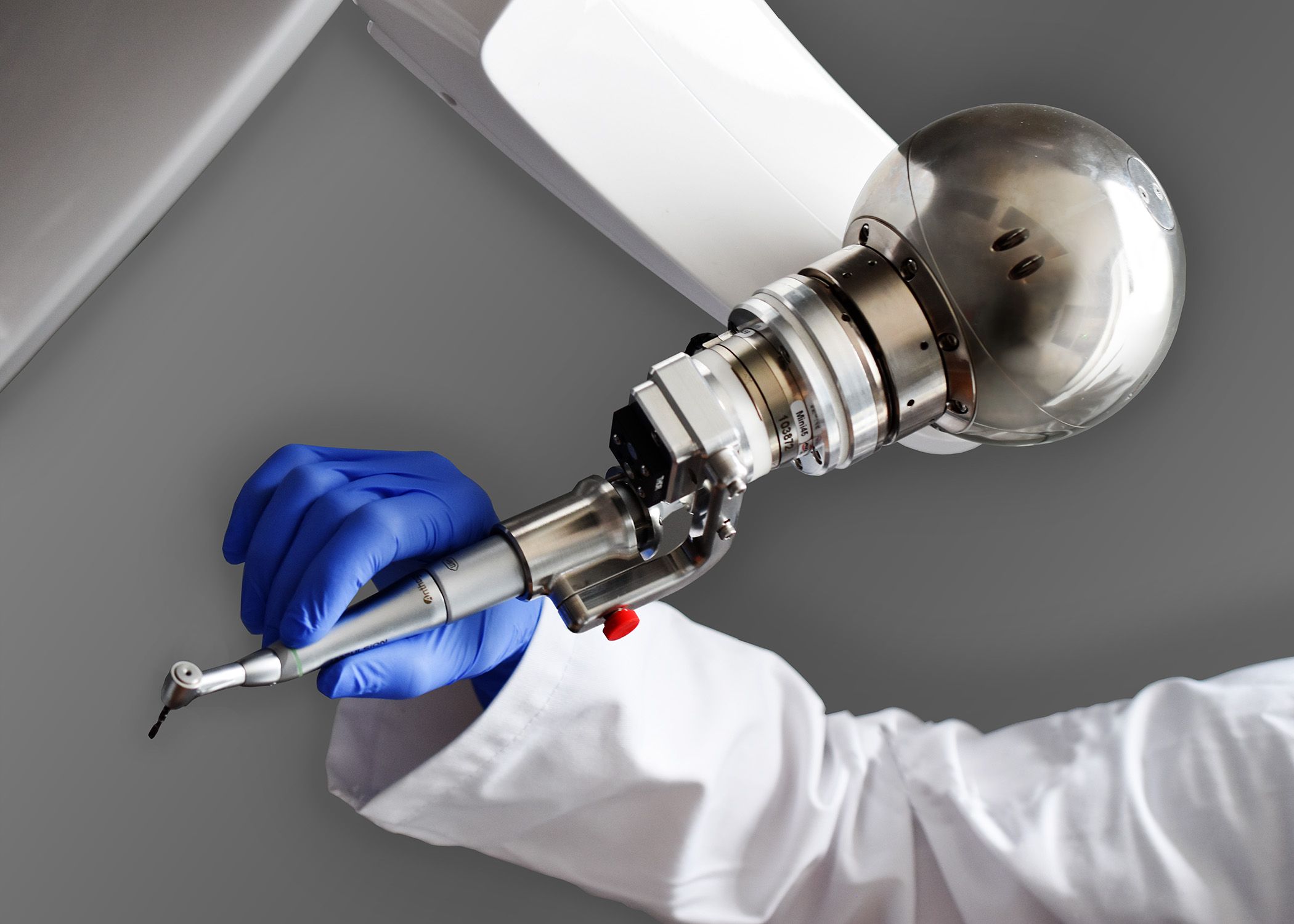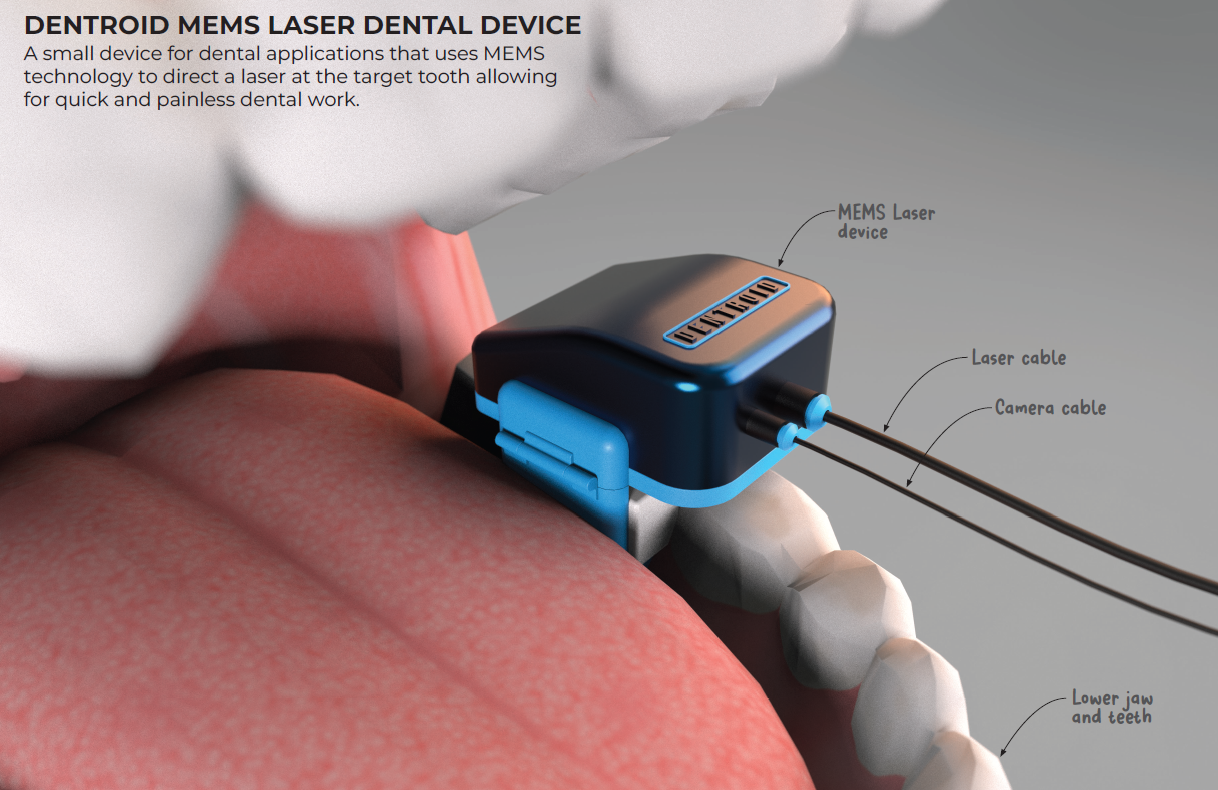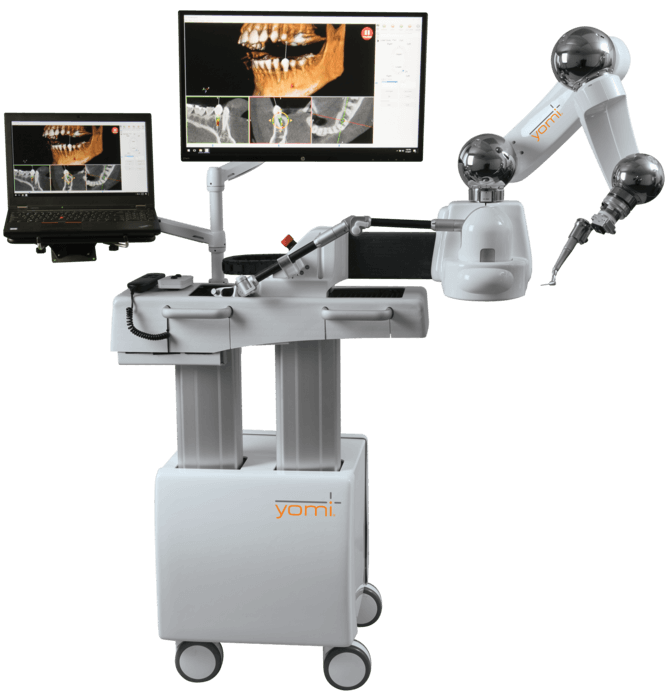Intraoral Dental Robots: The Present, Near, and Far Future of the Integrations of the Sciences
While often seen as the future of dentistry, intraoral dental robots are already taking up residence in the dental operatory.
The Yomi Robotic Surgery Platform from Neocis enables clinicians to plan everything on a digital image and a CT scan ahead of time.

Robots might seem more at home cast as quirky sidekicks in a science fiction movie. However, intraoral dental robots also reside in the dental operatory. We talk to 2 dental robot experts to explore the present, near, and far future of robotic integrations in the dental practice.
Neil Patel, DMD, MBA, is passionate about the potential of robotics to democratize access to affordable, high-quality dental care. Dr Patel studied physics and mechanical engineering at Duke University and Caltech, attended dental school, and then practiced at a nonprofit dental clinic he built in his community treating underserved individuals before completing his MBA at Northwestern University’s Kellogg School of Management.
Dr Patel’s unique educational background serves as the foundation for his career and life philosophy. His mission is to integrate the principles of spirituality and mathematics to create a more harmonious and unified world. “Everything in life is about finding the right balance, energy, frequency, and vibration. When you achieve that perfect combination, amazing things can happen,” Dr Patel says.
Currently, Dr Patel is the chief product officer of Dentroid, an Australian start-up leading the light revolution in dentistry. “Dentroid aims to introduce the most significant paradigm shift in the history of dental treatment, making the entire experience kinder, more convenient, and pain-free,” he says.
Dentroid is revolutionizing dentistry by using advanced lasers and miniature robotics to treat patients without traditional tools such as needles, water sprays, or drills, according to Dr Patel. Their pain-free treatment uses a femtosecond laser, similar to those used in ophthalmology, to precisely prepare teeth through ablation. The device removes soft and hard tissues using ultrashort pulses to avoid heating the tooth structure, making it painless and eliminating the need for anesthesia shots.
Dentroid's laser device is placed in the mouth and anchored in specific areas next to the tooth designated for restoration or crown construction. It scans the existing tooth structure and offers the dentist a digital display of the tooth. The built-in smart analytics and diagnostic aids will support the clinician in making the right diagnostic decision and mitigate indiscriminate/accidental removal of otherwise healthy tooth structure

“Currently, Dentroid focuses on automated and precise tooth preparation, allowing dentists to deliver prefabricated fillings and crowns without the need for any adjustments, which leads to incredible gains in the quality and efficiency of care,” Dr Patel says. “This technology streamlines and automates care delivery through a miniaturized tooth-mounted robot powered by advanced photonics, micro-engineered parts, artificial intelligence, sensor fusion, and novel imaging techniques. The robot scans the tooth and uses artificial intelligence to highlight pathology, such as caries, and suggest a minimally invasive preparation and restoration. After review and feedback from the dentist, the device automatically preps the tooth without water or anesthesia. This allows for comfortable, fast, precise, automatic, and minimally invasive treatment.”
Dr Patel believes intraoral robotic technology is the future of dentistry and is the key to providing affordable, quality dental care. “By automating care with incredible accuracy down to the micron level, Dentroid’s robotics frees dentists to focus on the human element of providing care to patients. This technology offers a disruptive shift in how care is delivered, with an incredible value proposition for both patients and dentists,” he says.
Alon Mozes, PhD, MECE, CEO and co-founder at Neocis Inc and a Massachusetts Institute of Technology alumni, says robotics enhances dentistry because human ability is limited. Mozes also says that if you look at dental implant surgery, and even more broadly into dental procedures, a lot of manual work relies on years of training for hand-eye coordination. Robotics is excellent for the accuracy and automation of workflows, he explains. “[In] dental implant surgery, [you’re drilling holes into bone, where [there are] nerves, sinuses, and other healthy teeth roots. You don’t want to damage any of those critical anatomical structures. If you’re doing it by hand, you’re taking a big risk that you don’t have to. Robotics will help them plan it all ahead of time, then execute it very precisely,” Mozes says.
Neocis manufactures Yomi, a US Food and Drug Administration (FDA)-cleared robotic surgery platform for the dental industry. Yomi enables clinicians to plan everything on a digital image and a CT scan ahead of time. The dentist can then drag and drop the implant wherever they want it and fine-tune that plan. Then during the delivery of the plan, the dentist gets manual support from the robot. Mozes compares it to lane assist with a car. “It will help them get the correct angle and position and ensure that when they’re at that correct trajectory, they don’t deviate from that plan,” Mozes says. “It’s going to keep you in the lane that you planned ahead of time.”
One of the benefits of working with dental robotics is that, because it is digital, dentists can change the plan in the software even in the middle of surgery, if necessary, Mozes says. Then the robot physically guides the dentist to the new, updated plan. “What’s most important,” Mozes says, “is [that] the robot creates a safe operation where the surgeon can’t deviate in terms of position, angle, or depth, so they are not as much at risk of doing any damage.”
The Yomi Robotic Surgery Platform from Neocis is FDA-cleared for dental procedures. It uses haptics to physically guide the clinician so that surgery goes exactly as planned. Similar to lane assist in modern cars, Yomi will correct the angle and position if it senses the user is drifting off course, keeping clinicians in the lane they planned ahead of time.

Furthermore, if the robot senses the surgeon is deviating from the plan, it will stop them. It physically limits the drill to the parameters determined by the treatment plan saved in the software. Mozes describes this scenario as feeling like the drill is on rails, guiding the clinicians on the desired trajectory. In addition, the Yomi platform shows them on the screen with audible beeps to help guide them. “On the screen, you’re seeing the CT scan, the real-time updated position of the patient, and the plan you originally made. You see where your drill is relative to everything. You get exactly what you planned every time between the beeping, the visual feedback, and the physical restrictions and guidance,” Mozes says.
Yomi’s most recent FDA clearance was for a new indication for bone reduction. This clearance represents an example of how robots can enhance human ability. For example, in significant, complex cases with multiple implants, bone reduction provides a flat surface to support the implants and seat the prosthetic. However, reducing the bone increases the risk of hitting a nerve, which makes some clinicians reluctant to reduce enough when free-handing it. “Now they can use the robot with the haptic boundaries it provides to drill the right depth and distal boundaries. It has a lingual border so it can be protective,” Mozes says. “It gives them the comfort and confidence to make a bone reduction accurately and efficiently.”
The Near Future of Robotics
Dentistry will be largely automated within the next 5 years, according to Dr Patel. Dentists and dental support organizations that embrace disruptive technology will quickly rush to adopt robotics in the next decade. Dentroid’s device can treat cavities, prepare crowns, and perform endodontic therapy. Additionally, the device will eventually treat the grooves and interproximal surfaces of teeth, making them permanently cavity resistant without the need for sealants. “How wild is that?” Dr Patel says.
Mozes sees the future of robotics in dentistry as a beginning to provide a proper comprehensive, end-to-end digital dental workflow. For example, Mozes says the platform helps surgeons drill the osteotomy exactly where they want to place the implant. However, he sees many more opportunities to help the dentist throughout the workflow. “If you think preoperatively, they have imaging and planning that they go through. We can help with better imaging diagnostics [and] more automation in the planning so they can get the implant exactly where they want at the ideal clinical position,” Mozes says. “Also, from a restorative perspective, they can take a true crown-down approach and think about how the prosthetics will drive where they want the surgical elements to go.”
Mozes says planning the prosthetics means improving the postoperative restorative workflow, particularly in printing or milling that restorative prosthetic in-house beforehand. This immediacy also enhances the patient experience. “Now you have a robotic system with Yomi that will help them execute the plan exactly as they intended, so you can have the prosthetics ready to go and have the patient get into their teeth much faster,” Mozes says. “The entire preoperative to interoperative to postoperative workflow becomes very streamlined with an automated robotic solution.”
Neocis’ Yomi platform’s first FDA clearance in 2016 was for single and multiple restorative workflows, but not full-arch ones. In 2020, the FDA cleared Yomi for full-arch cases, which Mozes thinks improves a complex workflow by providing clinicians the platform to plan it in the system before ever picking up a drill. He says with preplanning facilitated by Yomi’s software, entire arch restorations resemble an assembly line instead of the trial-and-error process often associated with freehanding the implant placements. “You just drill out all those osteotomies and place the implants exactly as planned. You can have your full-arch prosthetic ready to go, so it just sits right onto those implants,” Mozes says. “There’s consistency in the automation, which plays a nice role in workflow efficiency and clinical accuracy.”
In addition, the Yomi system allows for improved collaboration between the stakeholders in the therapeutic process. The placement and restorative repercussions agreements are decided beforehand, making it easier for everyone involved. It facilitates thinking about the whole implant process as a restorative one. Moreover, as the software improves, the platform can create a suggested restorative plan considering all the different constraints involved in an individual case. “It’s not crazy to think over time that the software, as it becomes more intelligent and more assistive, will help by providing an optimal plan,” Mozes says.
The More Distant Future of Intraoral Robotics
Of course, some dentists may find it difficult to accept this technology, Dr Patel says. However, he sees this as a generational issue. He believes younger dentists will be more willing to adopt new technologies. He also sees dental service organizations playing a significant role in adopting the technology.
“The corporate groups that have money and understand the value will be the driving force to implement the technology,” Dr Patel says. He adds that the volume of services these organizations perform will build patient awareness about the benefits of the technology. “Patients will realize they can receive treatment in a fraction of the time it takes now, without the need for anesthesia and with a perfect result. It may even be cheaper. They will wonder why they would ever go to any other dentist.”
Dr Patel has always had a passion for engineering. He is a self-proclaimed science nerd and an inventor who would break stuff just to see whether he could put it back together. “Sometimes I’d be stumped, but other times, I’d nail it. And once in a blue moon, I’d even make something better,” he says.
Dr Patel’s take on the future of intraoral robots in dentistry is enthusiastic. He sees robots as the path forward to elevating patient care in dentistry and any other discipline of medicine. He also envisions changing the way patients, dentists, and medical doctors interact, mainly through decentralized autonomous organizations (DAOs). Through these DAOs, patients, health care providers, insurance companies, and [investigators] would interact in new ways, which would support community decision-making and build trust between all parties.1
However, as he explains, getting there will take several steps. Once robotics experts achieve predictability with one technology, they move on to the next phase, and then the next. Dr Patel envisions a future that leverages those strengths to develop something more versatile. This feeds his enthusiasm for the future of health care robotics and his advocacy for its integration into every practice.
One of his favorite quotes is from Eleanor Roosevelt: “The future belongs to those who believe in the beauty of their dreams.
“In dentistry, that future is already here with the transformative impact of robotics. From treating cavities to performing endodontic therapy, the potential for robotics in dentistry is limitless,” Dr Patel says.
“Let us embrace this exciting new technology with open hearts and minds and use it to revolutionize the way we deliver care,” he adds. “With robotics, we can democratize access to affordable, high-quality dental care and make the entire experience kinder, more convenient, and pain free. So let us believe in the beauty of our dreams and work together to create a brighter future for all.”
Reference
- Mateus S, Sarkar S. Can decentralized autonomous organizations (DAOs) revolutionize healthcare? California Management Review. January 2, 2023. Accessed March 30, 2023. https://cmr.berkeley.edu/2023/01/can-decentralized-autonomous-organizations-daos-revolutionize-healthcare/